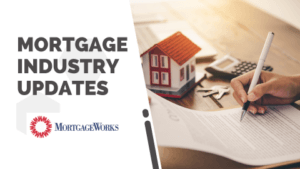Mortgage Industry Updates: Crucial Info for Coachella Buyers

As the mortgage industry continues to evolve, staying updated on Mortgage Industry Updates is crucial for homebuyers in the Coachella Valley. This post will provide you with helpful info on recent movements and tendencies that could influence your decision-making process when buying a home.
We’ll start by discussing the role of 10-year treasury bond yield in predicting mortgage rate trends and examining how a decline in consumer spending might affect the federal funds rate. Next, we’ll delve into reverse mortgages for senior homeowners and explore their flexible repayment terms and unique features, such as no required monthly payments.
Additionally, this post will offer an informative breakdown of closing costs, including nonrecurring third-party fee-based charges like appraiser fees and credit report fees and recurring or prepaid expenses like homeowner’s insurance and property taxes. Finally, we’ll touch upon preferred jumbo loan programs that allow loans up to $1 million with only a 20% down payment requirement while also addressing the potential implications of price adjustment factors increase by the Federal Housing Finance Agency.
Stay tuned for these essential mortgage industry updates to help you make informed decisions about your home purchase journey in Coachella Valley.
Mortgage Industry News
Stay informed on financial markets, CPI, and consumer spending to make an educated decision when searching for a mortgage in Coachella Valley, as these factors influence rates and potential recession. Staying abreast of CPI, consumer spending and financial market trends can assist in selecting the best home loan option for Coachella Valley. This section will discuss how these elements may impact mortgage rates and whether a recession is likely in the near future, according to economist Dr. Christopher Thornburg.
The Role of 10-Year Treasury Bond Yield in Predicting Mortgage Rate Trends
The 10-year treasury bond yield is an important benchmark for predicting long-term interest rate trends, including mortgage-related ones. When yields rise or fall, it’s common for mortgage rates to follow suit since lenders often use them as guidance when setting their own interest rates. For example, lenders may raise their mortgage rates accordingly if investors demand higher bond returns due to inflation concerns or other economic factors.
Consumer Spending Decline’s Potential Effect on Fed Funds Rate
The Fed’s decisions on monetary policy are heavily influenced by the GDP growth that consumer spending contributes to. If consumer spending is not steady, such as due to joblessness or greater household debt, the Fed may lower its fed funds rate in an attempt to generate economic activity.
A decrease in the Fed funds rate typically leads banks and other lending institutions to lower their interest rates, making mortgages more affordable for homebuyers. However, monitoring the overall economic landscape and consulting with a mortgage professional like MortgageWorks when considering your options is essential.
By staying informed about these key factors affecting the mortgage industry, you’ll be better equipped to navigate the ever-changing market conditions and find a suitable home loan that meets your needs in Coachella Valley.
Staying abreast of the mortgage market and its changes is essential for understanding present-day rates and financial movements. Reverse mortgages offer a unique solution for senior homeowners looking for flexible repayment options with no required monthly payments.
Key Takeaway:
Keep abreast of the newest developments in finance, CPI, and consumer expenditure related to mortgages. The 10-year treasury bond yield is an important benchmark for predicting long-term interest rate trends in the mortgage industry. At the same time, a decline in consumer spending could prompt the Fed to lower its federal funds rate to stimulate economic activity.
Reverse Mortgages for Senior Homeowners

As the aging population increases, many elderly homeowners struggle to manage their mortgage payments. In response to this growing need, a new product called HomeSafe Second Mortgage has been developed specifically for seniors with reverse mortgages who are struggling financially. This innovative solution offers flexible term options and unique features that make it attractive for those looking to secure their financial future.
Flexible Repayment Terms Ranging from 10 to 20 Years
The HomeSafe Second Mortgage allows borrowers to choose repayment terms between 10 and 20 years. This allows seniors to select a plan that best fits their individual needs and financial situation. By offering such a wide range of repayment options, this program helps ensure that seniors can find a suitable solution without feeling overwhelmed or burdened by rigid loan structures.
No Required Monthly Payments Feature
A standout feature of the HomeSafe Second Mortgage is its no-required monthly payments option. Seniors who opt for this feature will not be obligated to make any monthly payments toward their loan balance during the life of the loan. Instead, interest accrues on the outstanding balance over time, which is then repaid when they sell their home or pass away.
This unique characteristic provides significant relief for older homeowners who may have limited income sources in retirement but still want access to funds through a reverse mortgage without adding another monthly expense into their budget. For further information about reverse mortgages, consult the Consumer Financial Protection Bureau’s comprehensive guide.
In summary, if you’re a senior homeowner struggling with your current mortgage payments, the HomeSafe Second Mortgage may be an ideal solution for you. With its flexible repayment terms and no required monthly payments feature, this innovative product can help secure your financial future while providing much-needed relief from ongoing mortgage expenses.
Reverse mortgages can be a great option for senior homeowners who are looking to stay in their homes, as they offer flexible repayment terms and no required monthly payments. It is essential to be aware of the closing costs connected with reverse mortgages if you are contemplating obtaining such a loan.
Key Takeaway:
The HomeSafe Second Mortgage is a new product for senior homeowners struggling with mortgage payments. It offers flexible repayment terms ranging from 10 to 20 years and a unique no required monthly payments feature, making it an attractive option for those looking to secure their financial future without adding another expense into their budget.
Closing Costs Breakdown
Before embarking on the home-buying journey, it’s important to know the various costs of obtaining a mortgage loan. These expenses can be divided into two main categories: nonrecurring third-party fee-based charges and recurring or prepaid closing costs. By gaining insights into each category, you can better prepare yourself financially during your home-buying journey.
Nonrecurring Third-Party Fee-Based Charges Explained
Nonrecurring third-party costs are one-time payments that must be made during the mortgage process. Some common examples include:
Appraiser fees: An appraiser is hired to assess the value of the property you plan to purchase. This ensures that the loan amount does not exceed its worth. The average cost for an appraisal ranges from $300-$500, depending on factors such as location and property size.
Credit report fees: Lenders will check your credit history before approving your loan application, which typically incurs a fee between $25-$50 per borrower.
Title search and insurance fees: A title search verifies that there are no outstanding liens or ownership disputes on the property, while title insurance protects against any future claims arising after closing. Title-related costs can range from $1k-$4k, varying significantly.
Recurring or Prepaid Closing Costs Overview
In addition to one-time charges like those mentioned above, you’ll also need to budget for recurring or prepaid closing costs. These expenses include:
Homeowner’s insurance: Lenders require borrowers to have homeowner’s insurance in place before closing on a mortgage. This coverage protects the borrower and lender against property damage due to fires, storms, or theft. The average annual cost of homeowner’s insurance typically lies between $300-$1,000, depending on the location and coverage level.
Property taxes: As a homeowner, you’re responsible for paying annual property taxes which your local government usually collects. The property taxes you pay are typically based on your home’s assessed value and can range from 0.5% – 2%.
Key Takeaway:
Knowing the various expenditures connected with securing a mortgage is critical when purchasing a house. Nonrecurring third-party fees are one-time charges such as appraiser and credit report fees while recurring or prepaid closing costs include homeowner’s insurance and property taxes. By understanding these expenses, you can better prepare yourself financially during your home-buying journey.
Preferred Jumbo Loan Program

If you’re a well-qualified borrower seeking loans for second homes or vacation properties, the Preferred Jumbo Loan Program is tailored just for you. Recent changes by the Federal Housing Finance Agency (FHFA) have made obtaining such loans more accessible than ever before. This article delves into the characteristics and advantages of this particular loan program.
Loans up to $1 million with only a 20% down payment requirement
The Preferred Jumbo Loan Program offers loans up to $1 million with as little as a 20% down payment requirement. This means that borrowers can secure financing for their dream vacation home without having to save an exorbitant amount of money upfront. Under the Preferred Jumbo Loan Program, borrowers need only a 20% down payment to secure financing for properties up to $1 million – in this case, that would be just $180,000 for a $900,000 property.
Impact of price adjustment factors increase by Federal Housing Finance Agency
In addition to offering attractive loan amounts and low down payment requirements, recent changes implemented by the FHFA have also positively impacted jumbo loan accessibility. The agency has increased its price adjustment factors (PAFs), which essentially lowers interest rates on these types of mortgages.
This change makes it even more appealing for well-qualified borrowers who are considering investing in second homes or vacation properties since lower interest rates translate into reduced monthly mortgage payments over time.
To sum it up, the Preferred Jumbo Loan Program presents an excellent opportunity for those looking to purchase high-value second homes or vacation properties while benefiting from favorable terms and conditions brought about by recent industry updates. If you’re considering taking advantage of the Preferred Jumbo Loan Program, contact a MortgageWorks loan expert for more information and to see if it suits your financial circumstances.
Key Takeaway:
The Preferred Jumbo Loan Program is a great option for well-qualified borrowers seeking loans for second homes or vacation properties. Recent changes by the Federal Housing Finance Agency have made obtaining such loans more accessible than ever before, offering attractive loan amounts and low down payment requirements with lower interest rates translating into reduced monthly mortgage payments over time.
Conclusion
Ultimately, staying informed on mortgage industry trends is essential for those hoping to buy a house in the Coachella Valley. The 10-year treasury bond yield and consumer spending decline can both have significant impacts on mortgage rates and Fed funds rate, making it important to keep an eye on these factors.
Reverse mortgages offer flexible repayment terms and no required monthly payments for senior homeowners, while understanding closing costs breakdowns can help buyers prepare financially. Additionally, the preferred jumbo loan program allows loans up to $1 million with only a 20% down payment requirement.
If you’re ready to take advantage of these mortgage industry updates and start your journey toward homeownership in the Coachella Valley, contact MortgageWorks today.

